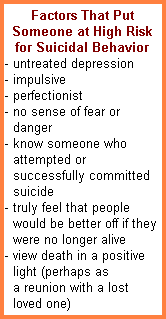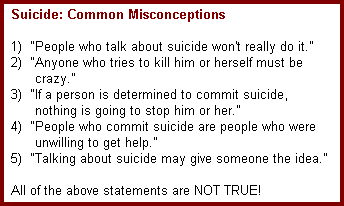Suicide and Crisis Planning
Every 40 SECONDS, someone in the world
commits suicide...
Source: Reuters, September 8, 2004
"Chance
favors the prepared mind." - Louis Pasteur
Depression can
be quite a difficult illness to deal with at times. It's
easy to get frustrated with the constant interference in life to
the point where we have nothing left to give. Unfortunately,
for individuals with untreated depression, there is a chance that
suicidal ideation will arise. During these grim times,
judgment is impaired to a great degree. Take the steps
necessary to prevent yourself from being placed in a position in which
you must make critical decisions about your treatment while your thought
processes are hindered. Crisis planning can be an excellent
way to map out instructions for yourself, and also for those who will
potentially be making treatment decisions on your behalf during
times such as these.
References
"Action
Planning for Prevention and Recovery: Crisis Planning"
Substance Abuse and Mental Health Service Administration
www.samhsa.gov
"Advance Psychiatric Directives"
Bazelon Center for Mental Health Law
www.bazelon.org
"Common
Misconceptions"
Suicide Awareness/Voices of Education
(SAVE)
www.save.org
"Facts About Suicide"
Suicide Awareness/Voices of Education (SAVE)
www.save.org
"Psychiatric
Hospitalization"
American Psychiatric Association
www.psych.org
"Someone You Know is Suicidal"
Suicide Awareness/Voices of Education (SAVE)
www.save.org
"Suicide:
The Problem"
Centers for Disease Control
www.cdc.gov
"Understanding and Helping the Suicidal Person"
American Association of Suicidology
www.suicidology.org
Warning
Signs of Suicide
- symptoms of depression
(see homepage
for list)
- talking, joking, or writing
about suicide
- threats
made pertaining
to suicide
- seeking access to means
(i.e. pills, firearms)
- preoccupation with death
- desire to seek revenge
-
acting recklessly
- increased drug or alcohol
abuse
- getting
one's things in order
- giving away possessions
- contacting people
whom
one cares about
- withdrawal from family,
friends,
etc.
- suddenly happier, calmer,
relieved
What
to Do If You're Suicidal
1) Utilize coping techniques
There is
a broad range of ways to cope. If you know which ones have proven
successful for you in the past, try those again. If one doesn't
work, move on to the next one. Some examples include breathing
techniques, journaling thoughts/feelings, and activities for distraction
(anything from reading a magazine to punching a punching bag).
2)
Reach out to other people
Fight the urge to isolate. Contact
friends, people from your support group, your therapist or psychiatrist,
etc. Not only can this be a welcomed distraction, it can also
give you a chance to vent and assess your need for additional assistance.
3)
Reduce dangers in your environment
Have someone stay with you
until you are confident the urge has passed. Get rid of any means
by which you could harm yourself: flush pills down the toilet, get
rid of bullets if there's access to a gun, don't get behind the wheel
of a car, etc. Ask the other person to hide or lock away medications,
sharp objects, etc.
4) Get professional help
If you're not
sure whether or not you're safe, chances are you aren't. You
deserve help. Suicide is what happens when pain exceeds coping
resources, so balance the scale by adding to your resources.
Suggestions:
-
call your therapist and/or psychiatrist and let
them know what's
going on
- take yourself in (if you feel safe getting there
on
your own) or call for an escort to the
hospital
- call the national
crisis line 1-800-SUICIDE
(784-2433) or a local crisis number
What
to Do If Someone You Know is Suicidal
1) Begin a direct conversation
on the topic
Truly listen to what they have to say and
comment in a non-judgmental fashion. Use some of the discussion
to gauge whether or not the person is in immediate danger.
2)
Avoid acting shocked
The stigma of suicidal ideation is present
already, so you don't want the person who needs help to
distance him or herself from you.
3) Don't assure secrecy
It's
never good to keep someone's plan to kill him or herself a secret.
Be prepared to get the necessary professional help.
4) Don't
minimize pain
Telling the person that it's really not that bad
will only make matters worse. Instead, offer to discuss the
reasons why he or she might be considering harming him or
herself.
5) Take action
If possible, stay with the person
and remove dangerous items in proximity to the suicidal individual.
This could include medications, guns, sharp objects, ropes, etc.
Do not let them get in the car and drive.
6) Seek professional
assistance
Contact a family member, psychiatrist, therapist,
community mental health agency, or suicide prevention and crisis center.
If the person is in immediate danger, accompany him or her to
a psychiatric facility or hospital emergency room.
Crisis Planning
Crisis plans are put in place to both serve
as a guide for the individual in crisis and ensure that the
individual receives the best care possible (based upon necessity
and desires), in the event that he or she is unable to make decisions regarding necessary
treatment. The process of creating an individualized crisis
plan is not typically something that happens overnight. Important
decisions, such as those mapped out in a contingency plan, require
thought, research, and input from professionals. The
crisis plan should be shared with your treatment team as well as the
people who might enact your plan on your behalf in the future.
You may even want to get a few signatures (from your treatment
team and others responsible for following your plan) whenever
the file is updated and distribute copies of the latest version to
those on your list of supporters. The following represents some
ideas regarding information you might be interested in including
in your crisis plan:
1) Pertinent Information
-
name
- contact info (address, e-mail,
phone numbers, etc.)
- treatment team
info (psychiatrist, therapist, etc.)
- insurance info
- last date crisis
plan was updated
2) Personal Instructions in Crisis
- descriptions and/or scales to help you determine if you're still
the one in control of the situation
- flow chart of which tactics to try when suicidal (for example, calling
a therapist, meditating, etc.)
- list
of people you could call for help
-
list of things to do before checking self into hospital (assuming
it's not an immediate emergency)
3) Instructions to Hand Over
Decision-Making to Someone Else
- list
of people (including contact info) in the order in which
you'd like them to be contacted (in
order to assume decision-making power over your treatment); It's a
good idea to have at least 5
people on the list, in the event that they are not able to be reached.
- list of signs that would indicate a transfer of power is necessary
(for example, unable to take
care of one's hygiene anymore)
- list
of signs that would indicate when power could be transfered back (for
example, able to take
care of oneself again)
4) Treatment
- current treatments (medications and dosages, types
of therapy, etc.)
- lists of medications
and other treatments that you would:
(a) prefer
(b)
accept, although not your first choice
(c) avoid at all costs
For
clarification, you might wish to state your reasons why for each of
the above.
- list of treatment centers
and/or hospitals that you prefer
If you have not yet had a chance to look into local treatment facilities,
describe what you
would
want from a program (setting, staff, room options/features, daily
activities, etc.)
- explanation
of your stance on research and clinical trial participation
- list of people you would hope could visit you, as well as those
you would like to prohibit from
visiting
you
5) Things to Be Done in Your Absence
- description of what to tell your place of work
- instructions regarding care of children, pets, and plants
- details about how to deal with mail, phone messages, and e-mails
received in the meantime
- what to do
about paying bills




When Hospitalization is Necessary: What to Expect
Although
it's not anyone's favorite thing in the world, sometimes hospitalization
cannot be avoided. Psychiatric care has changed dramatically
over the years. Nowadays, the goal is rapid stabilization, which
translates to shorter hospital stays. The hospital experience
will differ among institutions so, if possible, do some research beforehand
about local hospitals and programs, in case you need to be admitted
in the future. In addition, there are step down programs (such
as partial hospitalization programs) available to facilitate your
reintegration back into the community, as well as provide a form
of more intense psychiatric care that does not require overnight
hospital stays.
Safety
When a person starts developing thoughts
of self-harm, the hospital is there to ensure their safety until
the episode has passed. (This applies, in particular, to
the patients who don't have adequate support systems at home.)
The following safety measures may be taken at the hospital:
- body
search (for concealed objects that could prove dangerous)
- no locks
on most doors within the ward (for ready access to a patient in trouble)
-
plastic eating utensils (and replacement of any other sharp items)
-
15 minute checks (so staff is aware of patient's activities/whereabouts
on ward)
- restraints or isolation (if patient, staff members, or other
patients are in immediate danger)
Rapid Stabilization
Patients
work closely with psychiatrists, nurses, and social workers each day
to try to determine the cause of the recent destabilization.
Psychiatrists might see the patient each morning during rounds, for
example, to update medication dosages; nurses might monitor vital
signs throughout the day and distribute medication; social workers
might engage the patient in individual therapy or counseling.
Routine
Activities
Activities may be scheduled throughout the day, sometimes
even posted for all patients to view, if they'd like. The
purpose of this routine is to fight the urge of the depressed patient
to withdraw from even the most basic activities such as hygiene, meals,
etc. Typically, a portion of the day is spent in individual
activities and a portion in group activities, with some free time
left over to make phone calls, entertain visitors, or relax into a
good book. Some of the activities you might experience
include:
- vital sign checks
- meal times
- medication times
- group therapy
-
family therapy
- educational lectures or workshops
- art, music, movement,
or pet therapy
- exercise
- entertainment (games, movies, etc.)
Discharge
Planning
Some hospitals encourage patients and their family members
to assume an active role in discharge planning--which could include
making appointments for consultations, locating support groups of
interest or other resources nearby, picking up new prescriptions,
etc.
Try
This Exercise
Create a "Life's To Do List." Think about
all of the things you have yet to experience in life and all
of the places you have yet to visit. Then, refer to this
growing list whenever you feel there is nothing positive left
in your life.
Advance
Psychiatric Directives
Navigating through the storm...










